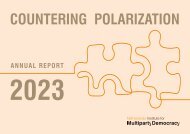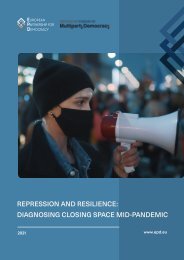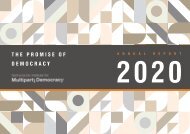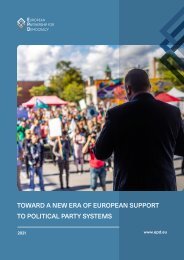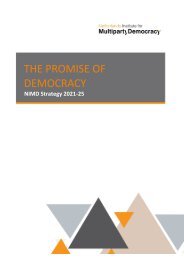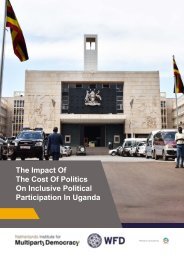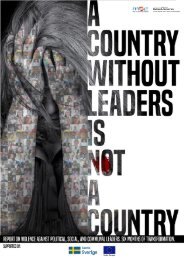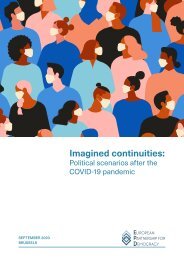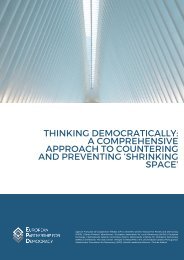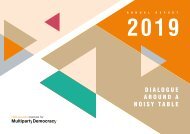Political Party Guidelines Eng
You also want an ePaper? Increase the reach of your titles
YUMPU automatically turns print PDFs into web optimized ePapers that Google loves.
1. Why gender equality in politics?
1.1 Myanmar and the global context
The number of women in national parliaments is globally one of the key ways to measure
gender equality in politics. It is certainly not the only one, but definitely one of the easiest ways, since
data exists from all over the world.
The Inter-Parliamentary Union (IPU) keeps a database on women’s situation in politics. As of January
2019, just 24,3% of MPs in national parliaments around the world were women. While the Nordic
countries have over 40% women in their parliaments, there are still three small countries with no
female legislators at all. Of the over 190 nations on IPU’s list, Myanmar is number 158, with 11,3%
women in the Lower House and 12,1% in the Upper House of Parliament. 4 Within the parties that
Myanmar School of Politics works with, there are five female Members of Parliament, two of which
have ministerial positions.
Why does this matter? What difference does it make, whether MPs are men or women? Is not the most
important thing that MPs are competent and work as hard as they can to realise the political objectives
of their respective parties?
A parliament, or committee with no women or a handful of women only does not seem strange to us
only because we are used to things being that way. In reality a parliament with minimal female representation
is not democratic, as half of the population in every country are women. In Myanmar,
women and men ratio is 100:93 5 . It is against the very principles of democracy, and against the rights
of women that women have no say over matters that are important to them. Yet the situation does not
strike us as faulty, because this fault has been with us for so long.
1.2 Two ways to justify women’s participation
Researchers have identified two types of argument for the promotion of women’s participation in politics.
The intrinsic approach argues from a human rights perspective that women must have an equal
share of politics and power. As women constitute half of the world’s population, it is fair that they
should also have half of the political power.
The human rights perspective: Gender equality is at the very heart of human rights, and
discrimination based on gender is prohibited under almost every human rights treaty. It is unfair and
wrong that women and girls routinely have their rights violated and are condemned to lives of poverty
because of gender discrimination and an unequal distribution of power and resources. It is our moral
duty to diminish these vast gender inequalities of opportunity and outcomes and uphold principles of
human dignity, equality, justice and freedom. Protecting and promoting women’s human rights is the
responsibility of all states. Number 5 of the 17 UN Sustainable Development Goals (SDGs; see Chapter
3.1), to which all the UN member states are committed to, is to achieve gender equality and empower
all women and girls. The right to political participation as a basic human right is highlighted here. 6
4
GUIDELINES FOR POLITICAL PARTIES IN MYANMAR




